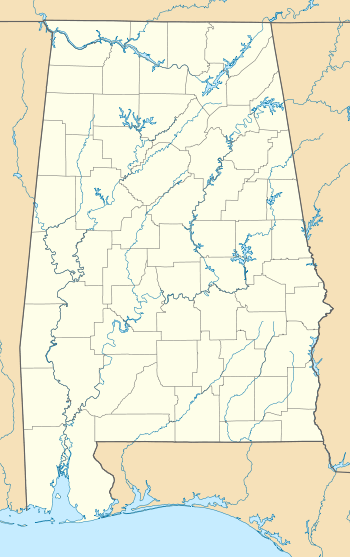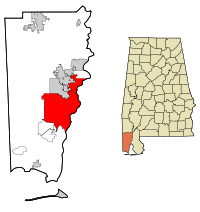National African American Archives and Museum
|
Davis Avenue Branch, Mobile Public Library | |
|
The National African American Archives and Museum in 2008. | |
  | |
| Location | 564 Davis Ave., Mobile, Alabama |
|---|---|
| Coordinates | 30°41′43″N 88°3′9″W / 30.69528°N 88.05250°WCoordinates: 30°41′43″N 88°3′9″W / 30.69528°N 88.05250°W |
| Area | less than one acre |
| Built | 1931 |
| Architect | George Bigelow Rogers |
| Architectural style | Classical Revival[1] |
| NRHP Reference # | 83003459[2] |
| Added to NRHP | December 22, 1983 |
The National African American Archives and Museum, formerly the Davis Avenue Branch of the Mobile Public Library, is an archive and history museum located in Mobile, Alabama. It serves as a repository for documents, records, photographs, books, African carvings, furniture, and special collections that all relate to the African American experience in the United States.[3]
History
The Davis Avenue Branch of the Mobile Public Library was built in 1931 to serve the needs of the local African American community.[4] The building was modeled after the Ben May Main Library but constructed on a smaller scale. The local African American community helped collect used books for the library and raise funds for the acquisition of new books. This reflected the social reality of segregation, when African Americans were prevented from participating fully in educational endeavors and were provided with separate educational facilities. Following desegregation, this branch library became a repository for government documents.[2] In 1992 it reopened as the National African American Archives and Museum. It was founded by Delores S. Dees, the organization's first president and executive director. The museum building is listed on the National Register of Historic Places and was designed by noted architect George Bigelow Rogers.[5]
Exhibits
Exhibits include the "History of Colored Carnival" that details the African American contribution to Carnival and Mardi Gras.[3] Also, the "Slavery Artifacts" exhibit features authentic displays of shackles, leg irons, slave collars, slave bracelets and slave badges from before the time of the Emancipation Proclamation.[3] On a more localized note, the museum also features artifacts representing the numerous contributions African Americans have made to greater Mobile.[5] It chronicles the voyage of the last known illegal slave ship, the Clotilde, which docked in Mobile in 1860 and led to the establishment of Africatown.[5] Mobile's African American community has produced such famous personalities as baseball legend Hank Aaron and U.S. Labor Secretary Alexis Herman, who both are represented in the museum's collection.[5] The museum contains a military section which displays memorabilia of Major general Jerome G. Cooper, the first African American to ever command a United States Marine Corps infantry company.
References
- ↑ "Alabama: Mobile County". "National Register Historic Places". Retrieved 2007-01-03.
- 1 2 National Park Service (2010-07-09). "National Register Information System". National Register of Historic Places. National Park Service.
- 1 2 3 "Itineraries: National African-American Archives Museum". "Mobile Bay Convention and Visitors Bureau". Retrieved 2007-12-11.
- ↑ Thomason, Michael. Mobile : the new history of Alabama's first city,pages 201-202. Tuscaloosa : University of Alabama Press, 2001. ISBN 0-8173-1065-7
- 1 2 3 4 "National African-American Archives Museum". "Soul of America". Retrieved 2007-12-11.
